2010 MERCEDES-BENZ GLK350 4MATIC snow chains
[x] Cancel search: snow chainsPage 17 of 344
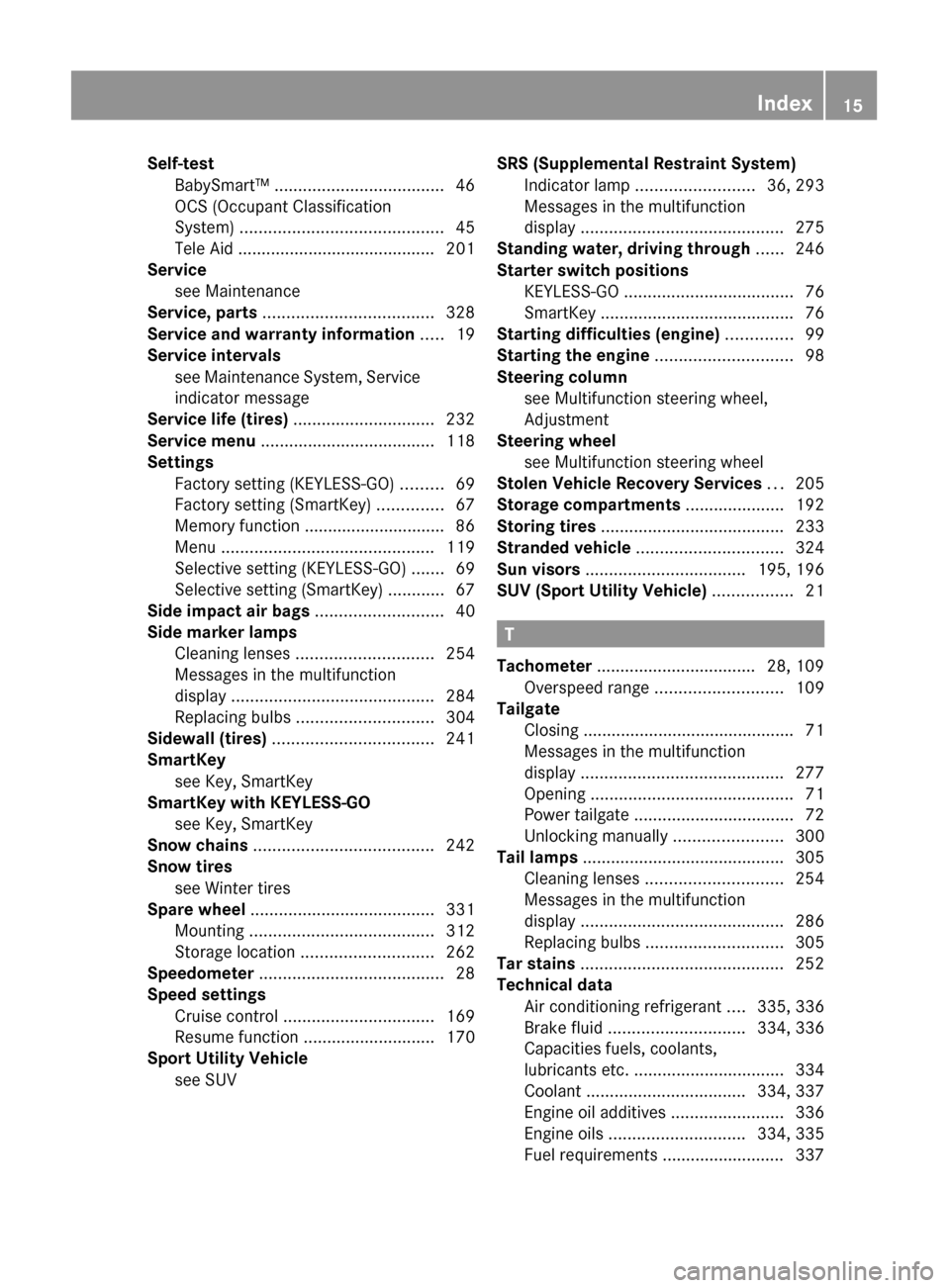
Self-test
BabySmart™ .................................... 46
OCS (Occupant Classification
System) ........................................... 45
Tele Aid .......................................... 201
Service
see Maintenance
Service, parts .................................... 328
Service and warranty information ..... 19
Service intervals see Maintenance System, Service
indicator message
Service life (tires) .............................. 232
Service menu ..................................... 118
Settings
Factory setting (KEYLESS-GO) .........69
Factory setting (SmartKey) ..............67
Memory function .............................. 86
Menu ............................................. 119
Selective setting (KEYLESS-GO) .......69
Selective setting (SmartKey) ............67
Side impact air bags ........................... 40
Side marker lamps
Cleaning lenses ............................. 254
Messages in the multifunction
display ........................................... 284
Replacing bulbs ............................. 304
Sidewall (tires) .................................. 241
SmartKey see Key, SmartKey
SmartKey with KEYLESS-GO
see Key, SmartKey
Snow chains ...................................... 242
Snow tires see Winter tires
Spare wheel ....................................... 331
Mounting ....................................... 312
Storage location ............................ 262
Speedometer ....................................... 28
Speed settings
Cruise control ................................ 169
Resume function ............................ 170
Sport Utility Vehicle
see SUV SRS (Supplemental Restraint System)
Indicator lamp ......................... 36, 293
Messages in the multifunction
display ........................................... 275
Standing water, driving through ...... 246
Starter switch positions
KEYLESS-GO .................................... 76
SmartKey ......................................... 76
Starting difficulties (engine) .............. 99
Starting the engine ............................. 98
Steering column see Multifunction steering wheel,
Adjustment
Steering wheel
see Multifunction steering wheel
Stolen Vehicle Recovery Services ... 205
Storage compartments ..................... 192
Storing tires ....................................... 233
Stranded vehicle ............................... 324
Sun visors .................................. 195, 196
SUV (Sport Utility Vehicle) ................. 21
T
Tachometer .................................. 28, 109
Overspeed range ........................... 109
Tailgate
Closing ............................................. 71
Messages in the multifunction
display ........................................... 277
Opening ........................................... 71
Power tailgate .................................. 72
Unlocking manually .......................300
Tail lamps ........................................... 305
Cleaning lenses ............................. 254
Messages in the multifunction
display ........................................... 286
Replacing bulbs ............................. 305
Tar stains ........................................... 252
Technical data
Air conditioning refrigerant ....335, 336
Brake fluid ............................. 334, 336
Capacities fuels, coolants,
lubricants etc. ................................ 334
Coolant .................................. 334, 337
Engine oil additives ........................336
Engine oils ............................. 334, 335
Fuel requirements .......................... 337
Index15X204_AKB; 3; 23, en-USd2ureepe,Version: 2.11.8.12009-07-16T19:16:58+02:00 - Seite 15
Page 18 of 344
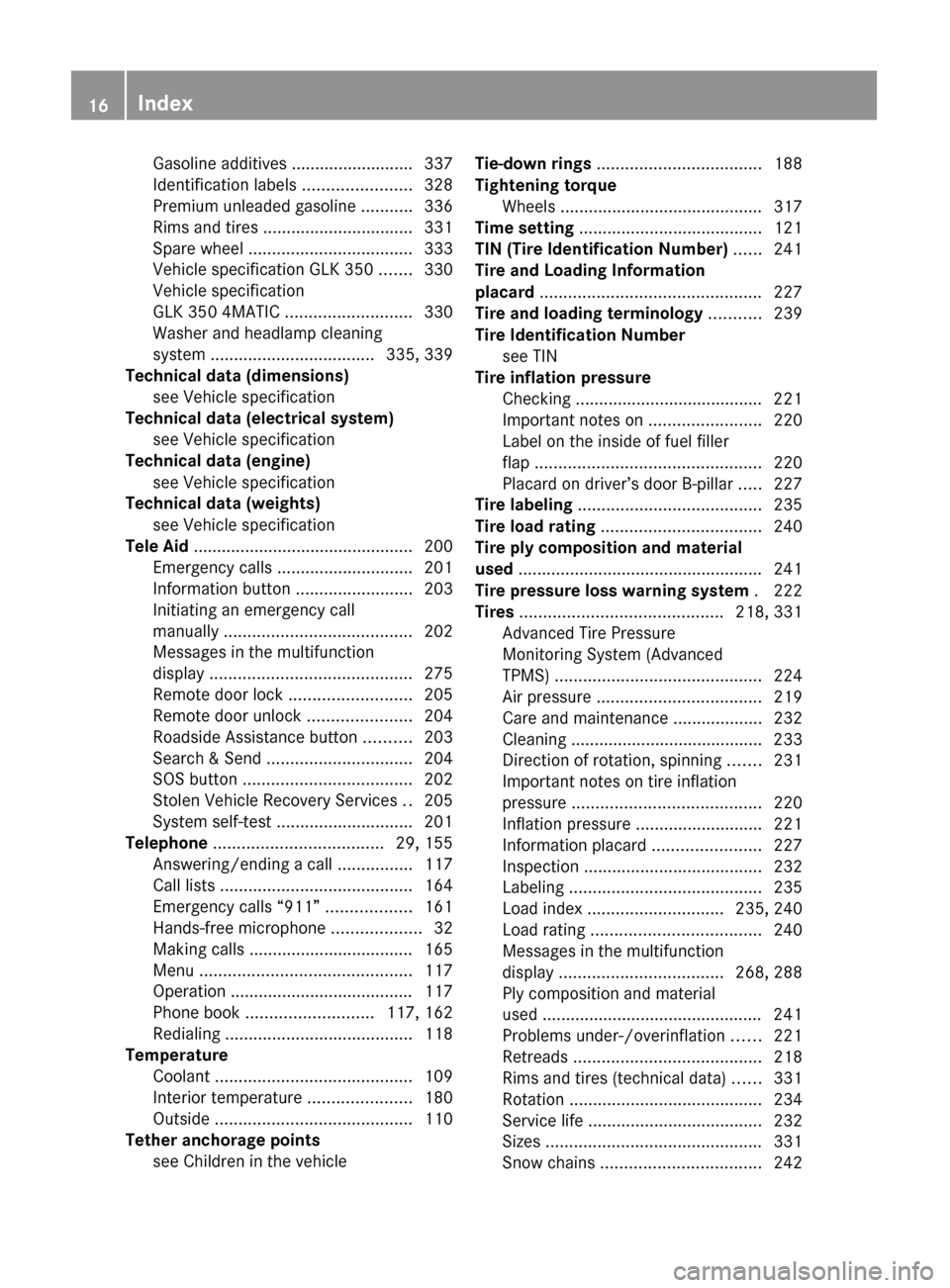
Gasoline additives .......................... 337
Identification labels .......................328
Premium unleaded gasoline ...........336
Rims and tires ................................ 331
Spare wheel ................................... 333
Vehicle specification GLK 350 .......330
Vehicle specification
GLK 350 4MATIC ........................... 330
Washer and headlamp cleaning
system ................................... 335, 339
Technical data (dimensions)
see Vehicle specification
Technical data (electrical system)
see Vehicle specification
Technical data (engine)
see Vehicle specification
Technical data (weights)
see Vehicle specification
Tele Aid ............................................... 200
Emergency calls ............................. 201
Information button .........................203
Initiating an emergency call
manually ........................................ 202
Messages in the multifunction
display ........................................... 275
Remote door lock .......................... 205
Remote door unlock ......................204
Roadside Assistance button ..........203
Search & Send ............................... 204
SOS button .................................... 202
Stolen Vehicle Recovery Services ..205
System self-test ............................. 201
Telephone .................................... 29, 155
Answering/ending a call ................117
Call lists ......................................... 164
Emergency calls “911” ..................161
Hands-free microphone ...................32
Making calls ................................... 165
Menu ............................................. 117
Operation ....................................... 117
Phone book ........................... 117, 162
Redialing ........................................ 118
Temperature
Coolant .......................................... 109
Interior temperature ......................180
Outside .......................................... 110
Tether anchorage points
see Children in the vehicle Tie-down rings ................................... 188
Tightening torque
Wheels ........................................... 317
Time setting ....................................... 121
TIN (Tire Identification Number) ...... 241
Tire and Loading Information
placard ............................................... 227
Tire and loading terminology ........... 239
Tire Identification Number see TIN
Tire inflation pressure
Checking ........................................ 221
Important notes on ........................220
Label on the inside of fuel filler
flap ................................................ 220
Placard on driver’s door B-pillar .....227
Tire labeling ....................................... 235
Tire load rating .................................. 240
Tire ply composition and material
used .................................................... 241
Tire pressure loss warning system . 222
Tires ........................................... 218, 331
Advanced Tire Pressure
Monitoring System (Advanced
TPMS) ............................................ 224
Air pressure ................................... 219
Care and maintenance ...................232
Cleaning ......................................... 233
Direction of rotation, spinning .......231
Important notes on tire inflation
pressure ........................................ 220
Inflation pressure ........................... 221
Information placard .......................227
Inspection ...................................... 232
Labeling ......................................... 235
Load index ............................. 235, 240
Load rating .................................... 240
Messages in the multifunction
display ................................... 268, 288
Ply composition and material
used ............................................... 241
Problems under-/overinflation ......221
Retreads ........................................ 218
Rims and tires (technical data) ......331
Rotation ......................................... 234
Service life ..................................... 232
Sizes .............................................. 331
Snow chains .................................. 24216IndexX204_AKB; 3; 23, en-USd2ureepe,Version: 2.11.8.12009-07-16T19:16:58+02:00 - Seite 16
Page 20 of 344
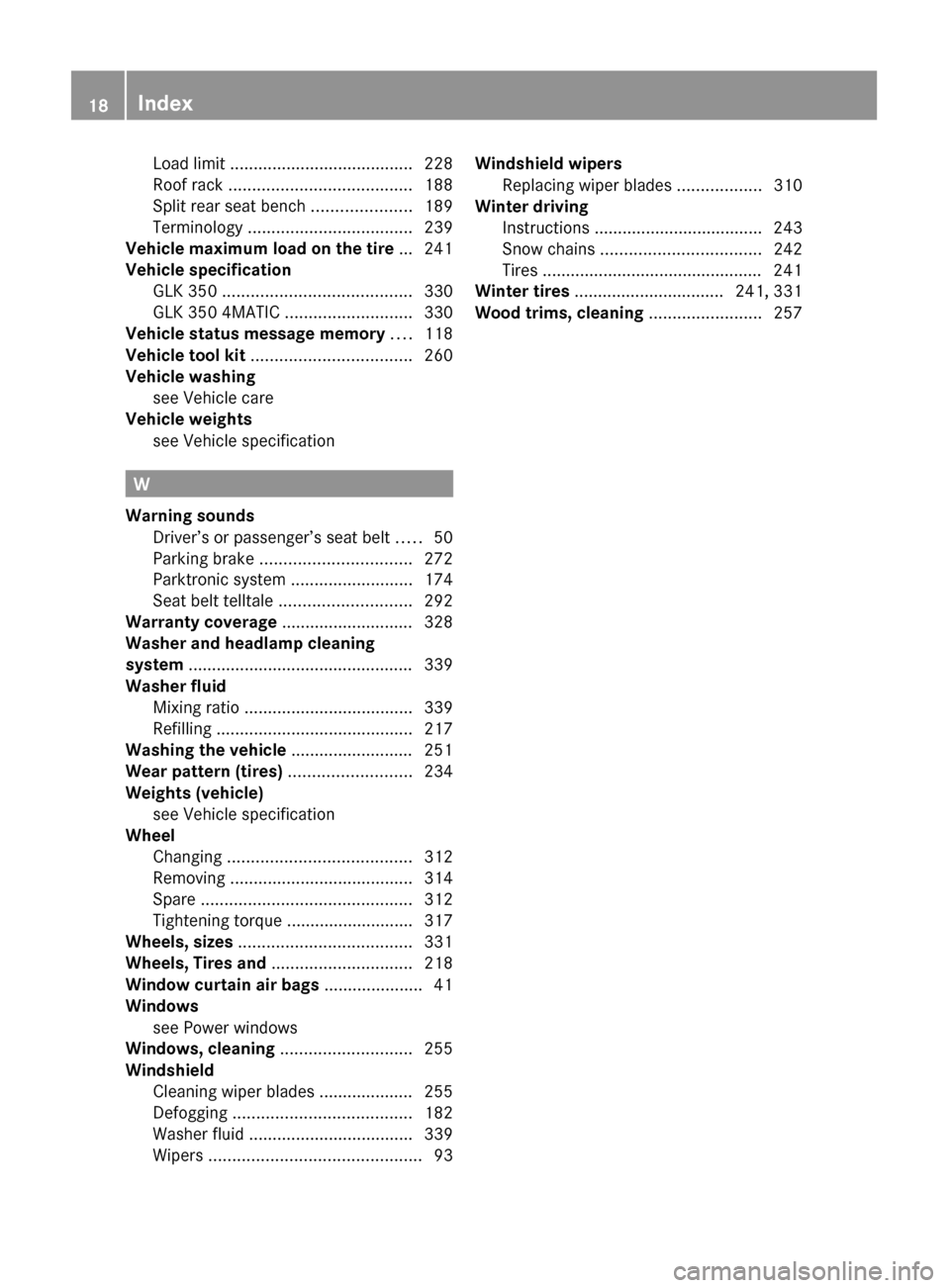
Load limit ....................................... 228
Roof rack ....................................... 188
Split rear seat bench .....................189
Terminology ................................... 239
Vehicle maximum load on the tire ... 241
Vehicle specification
GLK 350 ........................................ 330
GLK 350 4MATIC ........................... 330
Vehicle status message memory .... 118
Vehicle tool kit .................................. 260
Vehicle washing see Vehicle care
Vehicle weights
see Vehicle specification
W
Warning sounds
Driver’s or passenger’s seat belt .....50
Parking brake ................................ 272
Parktronic system ..........................174
Seat belt telltale ............................ 292
Warranty coverage ............................ 328
Washer and headlamp cleaning
system ................................................ 339
Washer fluid
Mixing ratio .................................... 339
Refilling .......................................... 217
Washing the vehicle .......................... 251
Wear pattern (tires) .......................... 234
Weights (vehicle) see Vehicle specification
Wheel
Changing ....................................... 312
Removing ....................................... 314
Spare ............................................. 312
Tightening torque ........................... 317
Wheels, sizes ..................................... 331
Wheels, Tires and .............................. 218
Window curtain air bags ..................... 41
Windows see Power windows
Windows, cleaning ............................ 255
Windshield
Cleaning wiper blades .................... 255
Defogging ...................................... 182
Washer fluid ................................... 339
Wipers ............................................. 93
Windshield wipers
Replacing wiper blades ..................310
Winter driving
Instructions .................................... 243
Snow chains .................................. 242
Tires ............................................... 241
Winter tires ................................ 241, 331
Wood trims, cleaning ........................ 25718IndexX204_AKB; 3; 23, en-USd2ureepe,Version: 2.11.8.12009-07-16T19:16:58+02:00 - Seite 18
Page 62 of 344
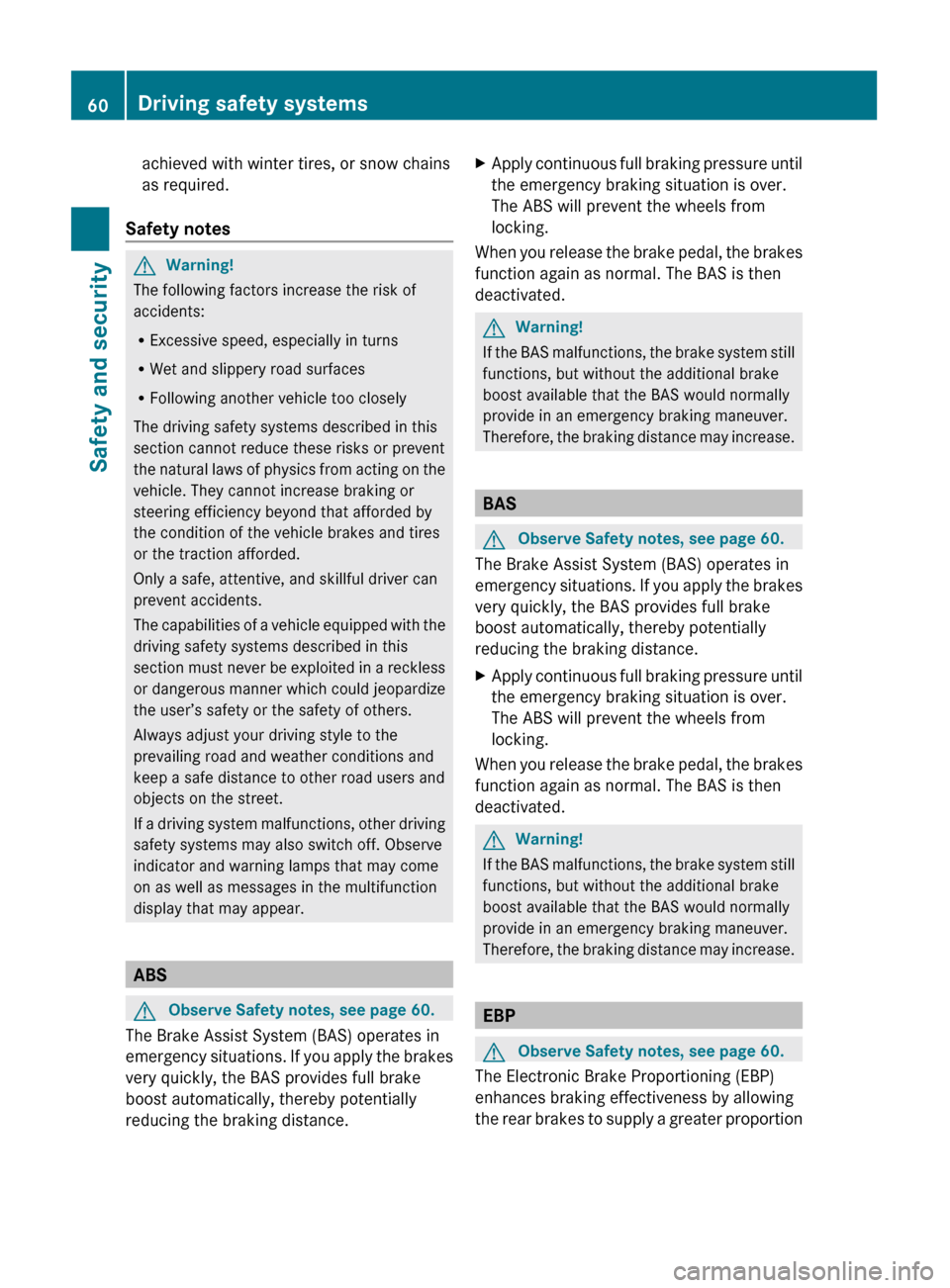
achieved with winter tires, or snow chains
as required.
Safety notesGWarning!
The following factors increase the risk of
accidents:
R Excessive speed, especially in turns
R Wet and slippery road surfaces
R Following another vehicle too closely
The driving safety systems described in this
section cannot reduce these risks or prevent
the natural laws of physics from acting on the
vehicle. They cannot increase braking or
steering efficiency beyond that afforded by
the condition of the vehicle brakes and tires
or the traction afforded.
Only a safe, attentive, and skillful driver can
prevent accidents.
The capabilities of a vehicle equipped with the
driving safety systems described in this
section must never be exploited in a reckless
or dangerous manner which could jeopardize
the user’s safety or the safety of others.
Always adjust your driving style to the
prevailing road and weather conditions and
keep a safe distance to other road users and
objects on the street.
If a driving system malfunctions, other driving
safety systems may also switch off. Observe
indicator and warning lamps that may come
on as well as messages in the multifunction
display that may appear.
ABS
GObserve Safety notes, see page 60.
The Brake Assist System (BAS) operates in
emergency situations. If you apply the brakes
very quickly, the BAS provides full brake
boost automatically, thereby potentially
reducing the braking distance.
XApply continuous full braking pressure until
the emergency braking situation is over.
The ABS will prevent the wheels from
locking.
When you release the brake pedal, the brakes
function again as normal. The BAS is then
deactivated.
GWarning!
If the BAS malfunctions, the brake system still
functions, but without the additional brake
boost available that the BAS would normally
provide in an emergency braking maneuver.
Therefore, the braking distance may increase.
BAS
GObserve Safety notes, see page 60.
The Brake Assist System (BAS) operates in
emergency situations. If you apply the brakes
very quickly, the BAS provides full brake
boost automatically, thereby potentially
reducing the braking distance.
XApply continuous full braking pressure until
the emergency braking situation is over.
The ABS will prevent the wheels from
locking.
When you release the brake pedal, the brakes
function again as normal. The BAS is then
deactivated.
GWarning!
If the BAS malfunctions, the brake system still
functions, but without the additional brake
boost available that the BAS would normally
provide in an emergency braking maneuver.
Therefore, the braking distance may increase.
EBP
GObserve Safety notes, see page 60.
The Electronic Brake Proportioning (EBP)
enhances braking effectiveness by allowing
the rear brakes to supply a greater proportion
60Driving safety systemsSafety and security
X204_AKB; 3; 23, en-USd2ureepe,Version: 2.11.8.12009-07-16T19:16:58+02:00 - Seite 60
Page 64 of 344
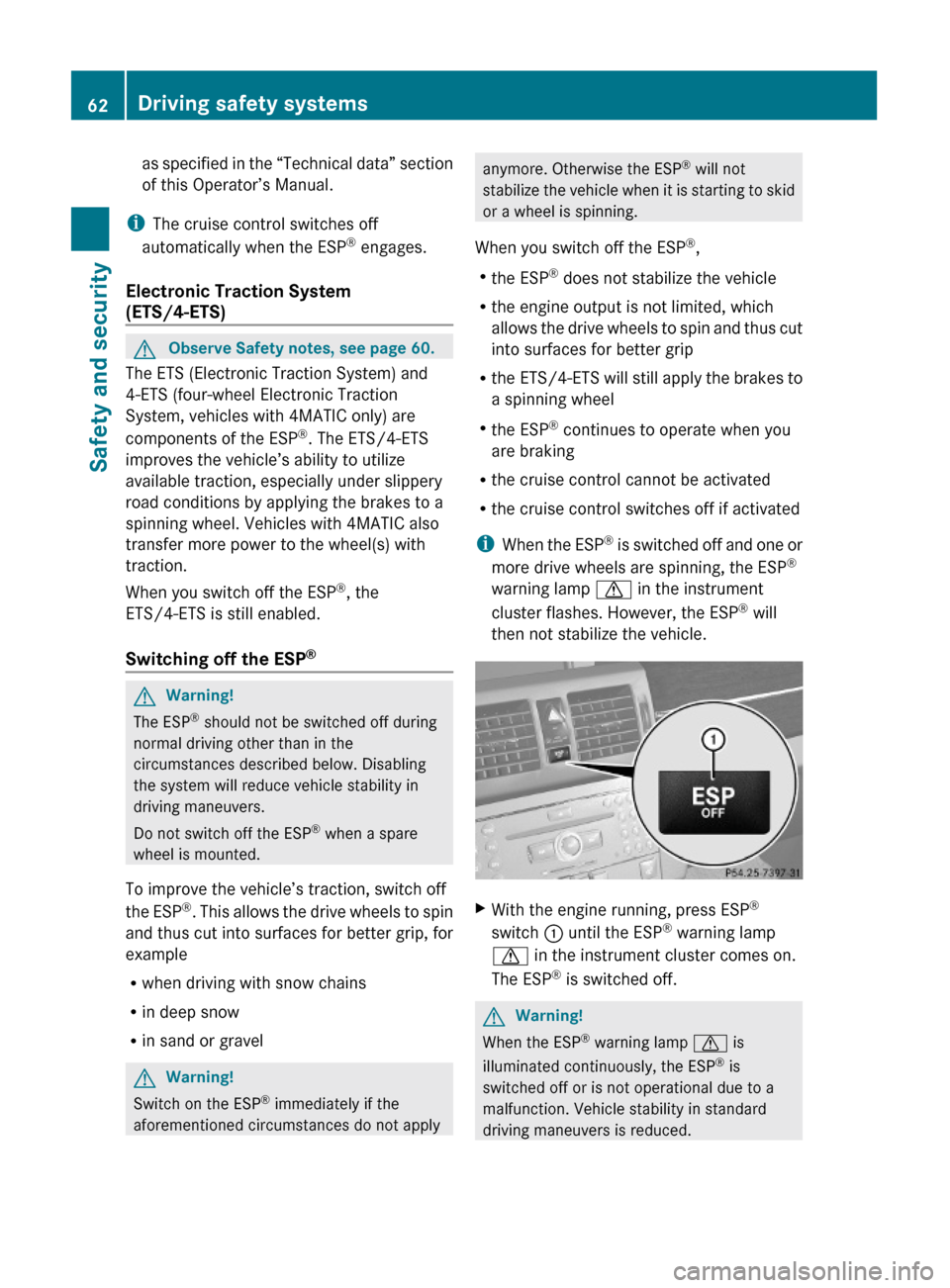
as specified in the “Technical data” section
of this Operator’s Manual.
iThe cruise control switches off
automatically when the ESP® engages.
Electronic Traction System
(ETS/4-ETS)
GObserve Safety notes, see page 60.
The ETS (Electronic Traction System) and
4-ETS (four-wheel Electronic Traction
System, vehicles with 4MATIC only) are
components of the ESP®. The ETS/4-ETS
improves the vehicle’s ability to utilize
available traction, especially under slippery
road conditions by applying the brakes to a
spinning wheel. Vehicles with 4MATIC also
transfer more power to the wheel(s) with
traction.
When you switch off the ESP®, the
ETS/4-ETS is still enabled.
Switching off the ESP®
GWarning!
The ESP® should not be switched off during
normal driving other than in the
circumstances described below. Disabling
the system will reduce vehicle stability in
driving maneuvers.
Do not switch off the ESP® when a spare
wheel is mounted.
To improve the vehicle’s traction, switch off
the ESP®. This allows the drive wheels to spin
and thus cut into surfaces for better grip, for
example
Rwhen driving with snow chains
Rin deep snow
Rin sand or gravel
GWarning!
Switch on the ESP® immediately if the
aforementioned circumstances do not apply
anymore. Otherwise the ESP® will not
stabilize the vehicle when it is starting to skid
or a wheel is spinning.
When you switch off the ESP®,
Rthe ESP® does not stabilize the vehicle
Rthe engine output is not limited, which
allows the drive wheels to spin and thus cut
into surfaces for better grip
Rthe ETS/4-ETS will still apply the brakes to
a spinning wheel
Rthe ESP® continues to operate when you
are braking
Rthe cruise control cannot be activated
Rthe cruise control switches off if activated
iWhen the ESP® is switched off and one or
more drive wheels are spinning, the ESP®
warning lamp d in the instrument
cluster flashes. However, the ESP® will
then not stabilize the vehicle.
XWith the engine running, press ESP®
switch : until the ESP® warning lamp
d in the instrument cluster comes on.
The ESP® is switched off.
GWarning!
When the ESP® warning lamp d is
illuminated continuously, the ESP® is
switched off or is not operational due to a
malfunction. Vehicle stability in standard
driving maneuvers is reduced.
62Driving safety systemsSafety and security
X204_AKB; 3; 23, en-USd2ureepe,Version: 2.11.8.12009-07-16T19:16:58+02:00 - Seite 62
Page 173 of 344
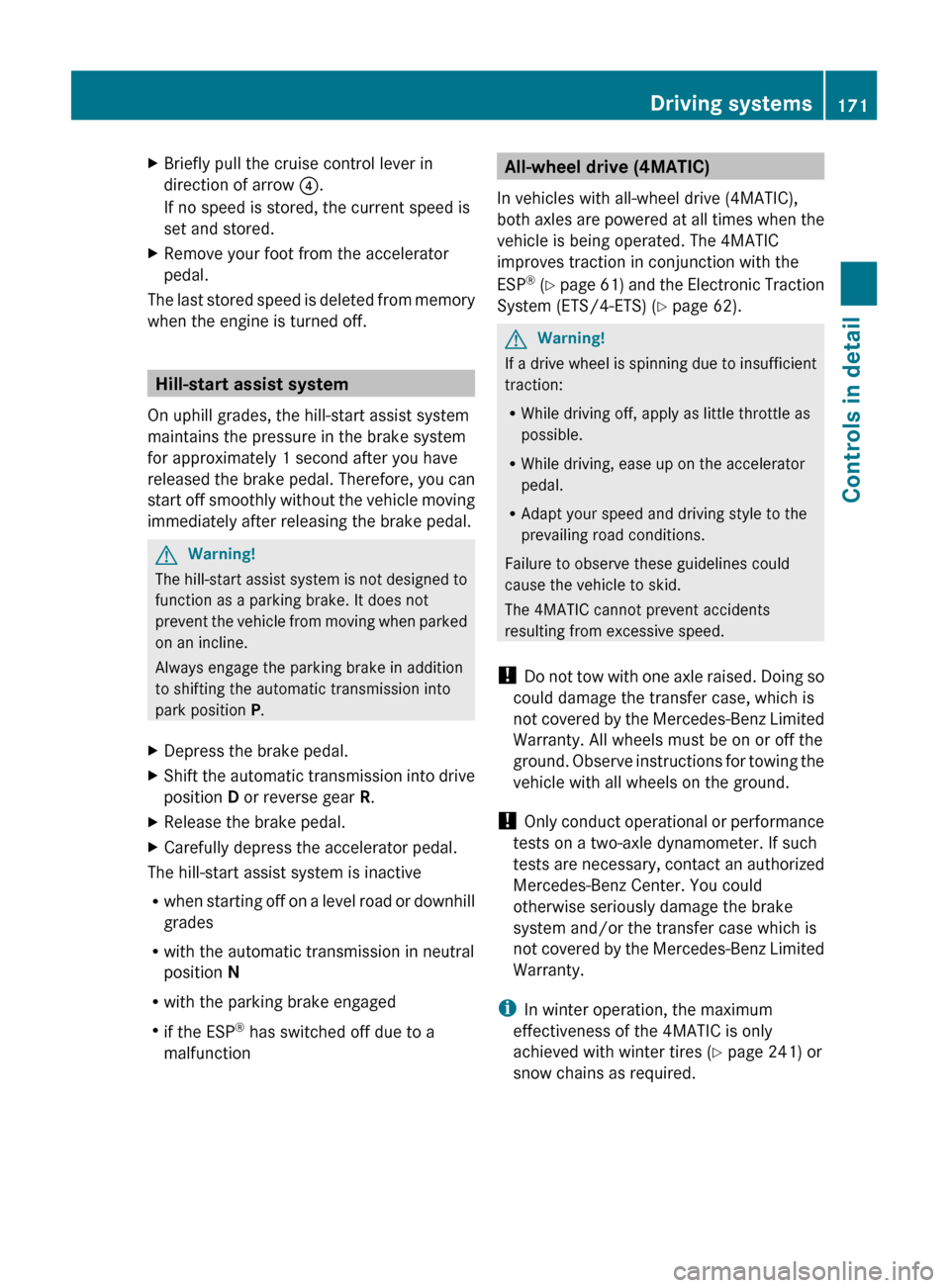
XBriefly pull the cruise control lever in
direction of arrow ?.
If no speed is stored, the current speed is
set and stored.XRemove your foot from the accelerator
pedal.
The last stored speed is deleted from memory
when the engine is turned off.
Hill-start assist system
On uphill grades, the hill-start assist system
maintains the pressure in the brake system
for approximately 1 second after you have
released the brake pedal. Therefore, you can
start off smoothly without the vehicle moving
immediately after releasing the brake pedal.
GWarning!
The hill-start assist system is not designed to
function as a parking brake. It does not
prevent the vehicle from moving when parked
on an incline.
Always engage the parking brake in addition
to shifting the automatic transmission into
park position P.
XDepress the brake pedal.XShift the automatic transmission into drive
position D or reverse gear R.XRelease the brake pedal.XCarefully depress the accelerator pedal.
The hill-start assist system is inactive
R when starting off on a level road or downhill
grades
R with the automatic transmission in neutral
position N
R with the parking brake engaged
R if the ESP ®
has switched off due to a
malfunction
All-wheel drive (4MATIC)
In vehicles with all-wheel drive (4MATIC),
both axles are powered at all times when the
vehicle is being operated. The 4MATIC
improves traction in conjunction with the
ESP ®
( Y page 61) and the Electronic Traction
System (ETS/4-ETS) ( Y page 62).GWarning!
If a drive wheel is spinning due to insufficient
traction:
R While driving off, apply as little throttle as
possible.
R While driving, ease up on the accelerator
pedal.
R Adapt your speed and driving style to the
prevailing road conditions.
Failure to observe these guidelines could
cause the vehicle to skid.
The 4MATIC cannot prevent accidents
resulting from excessive speed.
! Do not tow with one axle raised. Doing so
could damage the transfer case, which is
not covered by the Mercedes-Benz Limited
Warranty. All wheels must be on or off the
ground. Observe instructions for towing the
vehicle with all wheels on the ground.
! Only conduct operational or performance
tests on a two-axle dynamometer. If such
tests are necessary, contact an authorized
Mercedes-Benz Center. You could
otherwise seriously damage the brake
system and/or the transfer case which is
not covered by the Mercedes-Benz Limited
Warranty.
i In winter operation, the maximum
effectiveness of the 4MATIC is only
achieved with winter tires ( Y page 241) or
snow chains as required.
Driving systems171Controls in detailX204_AKB; 3; 23, en-USd2ureepe,Version: 2.11.8.12009-07-16T19:16:58+02:00 - Seite 171Z
Page 224 of 344
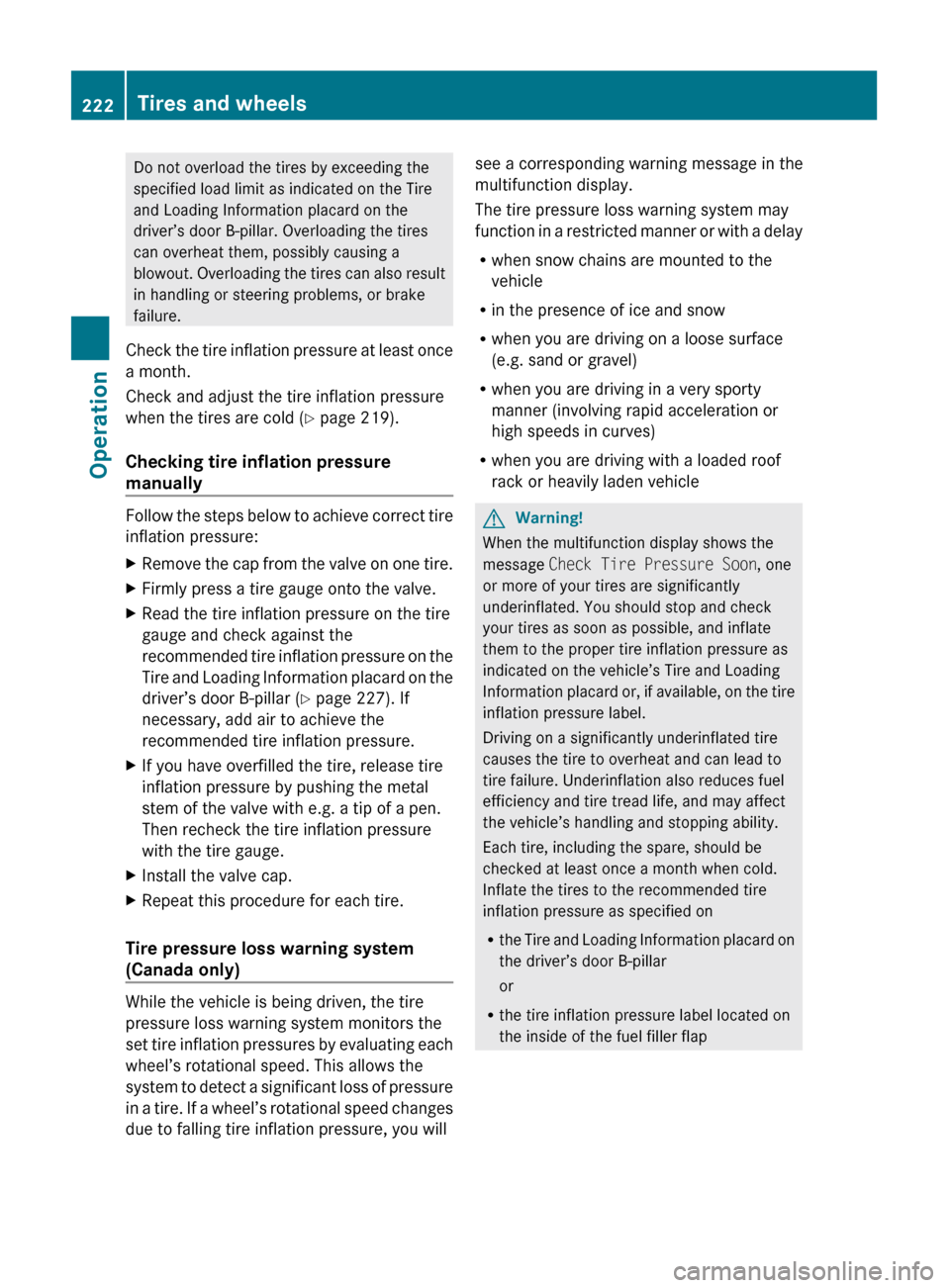
Do not overload the tires by exceeding the
specified load limit as indicated on the Tire
and Loading Information placard on the
driver’s door B-pillar. Overloading the tires
can overheat them, possibly causing a
blowout. Overloading the tires can also result
in handling or steering problems, or brake
failure.
Check the tire inflation pressure at least once
a month.
Check and adjust the tire inflation pressure
when the tires are cold ( Y page 219).
Checking tire inflation pressure
manually
Follow the steps below to achieve correct tire
inflation pressure:
XRemove the cap from the valve on one tire.XFirmly press a tire gauge onto the valve.XRead the tire inflation pressure on the tire
gauge and check against the
recommended tire inflation pressure on the
Tire and Loading Information placard on the
driver’s door B-pillar ( Y page 227). If
necessary, add air to achieve the
recommended tire inflation pressure.XIf you have overfilled the tire, release tire
inflation pressure by pushing the metal
stem of the valve with e.g. a tip of a pen.
Then recheck the tire inflation pressure
with the tire gauge.XInstall the valve cap.XRepeat this procedure for each tire.
Tire pressure loss warning system
(Canada only)
While the vehicle is being driven, the tire
pressure loss warning system monitors the
set tire inflation pressures by evaluating each
wheel’s rotational speed. This allows the
system to detect a significant loss of pressure
in a tire. If a wheel’s rotational speed changes
due to falling tire inflation pressure, you will
see a corresponding warning message in the
multifunction display.
The tire pressure loss warning system may
function in a restricted manner or with a delay
R when snow chains are mounted to the
vehicle
R in the presence of ice and snow
R when you are driving on a loose surface
(e.g. sand or gravel)
R when you are driving in a very sporty
manner (involving rapid acceleration or
high speeds in curves)
R when you are driving with a loaded roof
rack or heavily laden vehicleGWarning!
When the multifunction display shows the
message Check Tire Pressure Soon , one
or more of your tires are significantly
underinflated. You should stop and check
your tires as soon as possible, and inflate
them to the proper tire inflation pressure as
indicated on the vehicle’s Tire and Loading
Information placard or, if available, on the tire
inflation pressure label.
Driving on a significantly underinflated tire
causes the tire to overheat and can lead to
tire failure. Underinflation also reduces fuel
efficiency and tire tread life, and may affect
the vehicle’s handling and stopping ability.
Each tire, including the spare, should be
checked at least once a month when cold.
Inflate the tires to the recommended tire
inflation pressure as specified on
R the Tire and Loading Information placard on
the driver’s door B-pillar
or
R the tire inflation pressure label located on
the inside of the fuel filler flap
222Tires and wheelsOperation
X204_AKB; 3; 23, en-USd2ureepe,Version: 2.11.8.12009-07-16T19:16:58+02:00 - Seite 222
Page 244 of 344
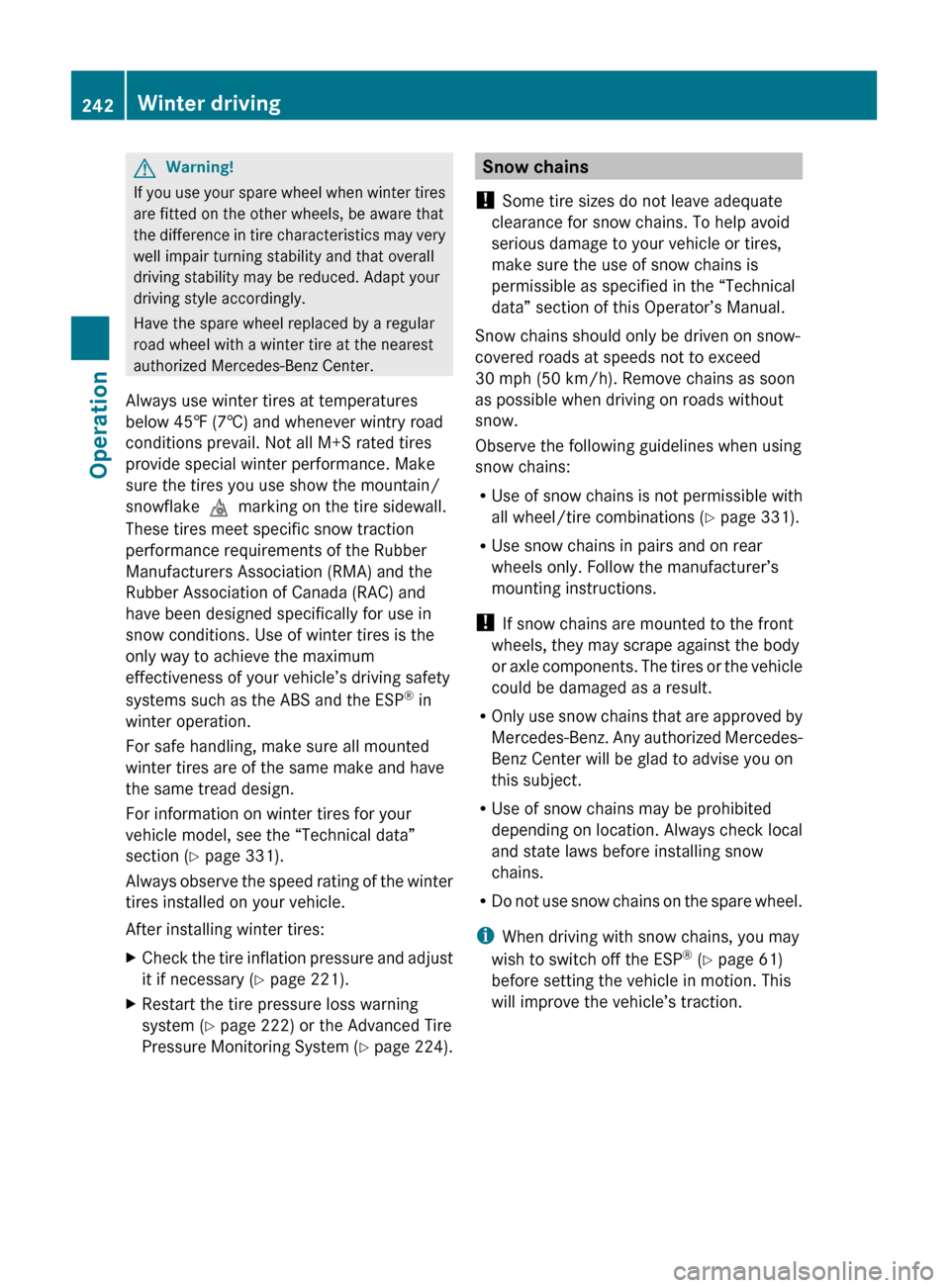
GWarning!
If you use your spare wheel when winter tires
are fitted on the other wheels, be aware that
the difference in tire characteristics may very
well impair turning stability and that overall
driving stability may be reduced. Adapt your
driving style accordingly.
Have the spare wheel replaced by a regular
road wheel with a winter tire at the nearest
authorized Mercedes-Benz Center.
Always use winter tires at temperatures
below 45‡ (7†) and whenever wintry road
conditions prevail. Not all M+S rated tires
provide special winter performance. Make
sure the tires you use show the mountain/
snowflake imarking on the tire sidewall.
These tires meet specific snow traction
performance requirements of the Rubber
Manufacturers Association (RMA) and the
Rubber Association of Canada (RAC) and
have been designed specifically for use in
snow conditions. Use of winter tires is the
only way to achieve the maximum
effectiveness of your vehicle’s driving safety
systems such as the ABS and the ESP ®
in
winter operation.
For safe handling, make sure all mounted
winter tires are of the same make and have
the same tread design.
For information on winter tires for your
vehicle model, see the “Technical data”
section ( Y page 331).
Always observe the speed rating of the winter
tires installed on your vehicle.
After installing winter tires:
XCheck the tire inflation pressure and adjust
it if necessary ( Y page 221).XRestart the tire pressure loss warning
system ( Y page 222) or the Advanced Tire
Pressure Monitoring System (Y page 224).Snow chains
! Some tire sizes do not leave adequate
clearance for snow chains. To help avoid
serious damage to your vehicle or tires,
make sure the use of snow chains is
permissible as specified in the “Technical
data” section of this Operator’s Manual.
Snow chains should only be driven on snow-
covered roads at speeds not to exceed
30 mph (50 km/h). Remove chains as soon
as possible when driving on roads without
snow.
Observe the following guidelines when using
snow chains:
R Use of snow chains is not permissible with
all wheel/tire combinations ( Y page 331).
R Use snow chains in pairs and on rear
wheels only. Follow the manufacturer’s
mounting instructions.
! If snow chains are mounted to the front
wheels, they may scrape against the body
or axle components. The tires or the vehicle
could be damaged as a result.
R Only use snow chains that are approved by
Mercedes-Benz. Any authorized Mercedes-
Benz Center will be glad to advise you on
this subject.
R Use of snow chains may be prohibited
depending on location. Always check local
and state laws before installing snow
chains.
R Do not use snow chains on the spare wheel.
i When driving with snow chains, you may
wish to switch off the ESP ®
(Y page 61)
before setting the vehicle in motion. This
will improve the vehicle’s traction.242Winter drivingOperation
X204_AKB; 3; 23, en-USd2ureepe,Version: 2.11.8.12009-07-16T19:16:58+02:00 - Seite 242